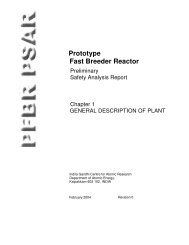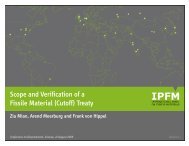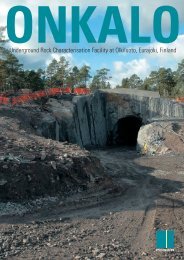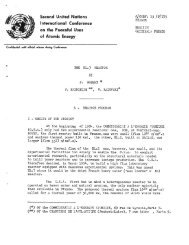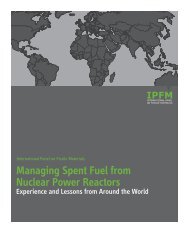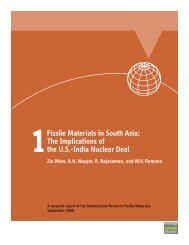Nuclear Proliferation TechnologyTrends Analysis - International ...
Nuclear Proliferation TechnologyTrends Analysis - International ...
Nuclear Proliferation TechnologyTrends Analysis - International ...
You also want an ePaper? Increase the reach of your titles
YUMPU automatically turns print PDFs into web optimized ePapers that Google loves.
PNNL -14480<br />
Although a number have countries have expressed an interest, only China has openly<br />
purchased centrifuge enrichment technology. It took three years from the time the<br />
agreement was signed until the facility (200,000 swu/yr) went into operation. Several<br />
factors were involved in this rapid development: 1) The Russian (Soviet) centrifuges<br />
were reportedly early models taken out of service that were immediately available and<br />
were known to be functional, 2) the Russians were very familiar with the technology and<br />
had proven ways of setting up the cascades and other parts of the facility, 3) the facility<br />
was constructed on a site where other enrichment technology existed, so proven UF 6<br />
infrastructure was available as were technicians trained in handling it.<br />
Brazil’s decision to construct a commercial facility could in some ways be considered a<br />
purchase, because the technology was developed by the Brazilian navy and was sold to a<br />
commercial entity. It took Brazil about 18 months to put their facility (20,000 swu/yr)<br />
into initial operation. This is about 1/10 th the size of the Russian/Chinese enrichment<br />
facility. As with the Chinese facility, the Brazilian commercial plant was located on a<br />
site where enrichment technology (an aerodynamic enrichment facility, see section 3.5)<br />
existed, so the infrastructure and trained personnel were available.<br />
From this, it can be inferred the minimum time to put a centrifuge enrichment facility into<br />
operation in a location with existing UF 6 technology infrastructure is between eighteen<br />
months and three years.<br />
3.2.4.1.3 Overt/covert acquisition<br />
At least five countries, Pakistan, Iraq, Iran, North Korea, and Libya, have acquired or<br />
attempted to acquire technology through covert means. The most successful of the five,<br />
Pakistan, may have been responsible for providing the means for the other four countries<br />
to develop their programs, especially Iran, North Korea, and Libya.<br />
Pakistan is a classic example of a country attempting to acquire technology through<br />
covert means. In order to bypass existing international controls, Pakistan was forced to<br />
develop an illicit international procurement network. The key technology holders and<br />
several of its leaders were in Pakistan. But many other leaders were spread throughout<br />
the world and located in Europe, Dubai in the United Arab Emirates, Turkey, South<br />
Africa, and Malaysia. The network also depended on a variety of unwitting<br />
manufacturing companies and suppliers on many continents. Buying components and<br />
assembling them in-country allowed Pakistan to develop an enrichment capability in nine<br />
years.<br />
In the mid 1980’s, when the Pakistani program was mature, the process changed, and<br />
some key members of the network decided to make the technology available to whoever<br />
would buy it 66,67 . While operational and producing HEU, the early Pakistani facilities<br />
suffered from severe quality problems. It may be inferred that this is because the<br />
66 Smuggling of Weapons of Mass Destruction, David Albright, Capitol Hill Hearing Testimony, June 23, 2004<br />
67 How Pakistani's network offered the whole kit; <strong>Nuclear</strong> proliferator/Scientist and black marketer, William J. Broad, David E.<br />
Sanger and Raymond Bonner, The <strong>International</strong> Herald Tribune, February 13, 2004<br />
32



